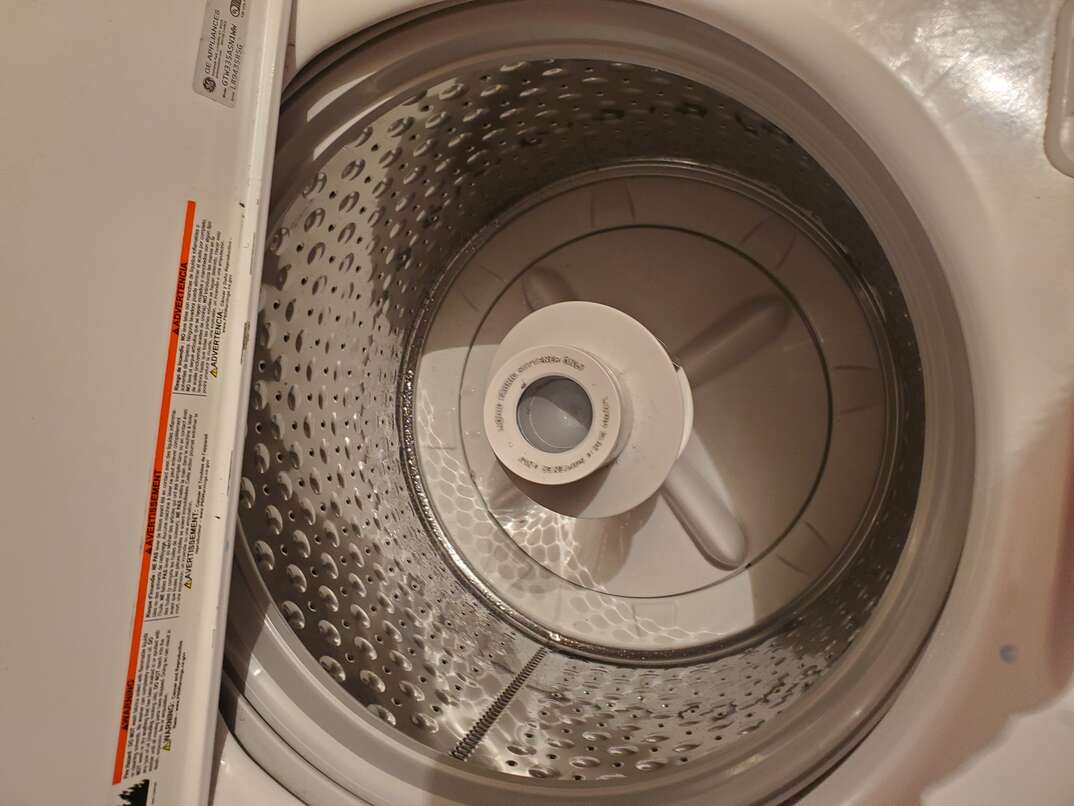My Washing Machine Won't Drain! Here are 3 Ways to Fix It

When home appliances quit working, it can cause a headache, to say the least. Having to go without an important appliance and getting stuck with a high repair bill can be super frustrating to any homeowner. But some appliances really take the cake in the frustration department when they stop working properly. Case in point: a washing machine that won’t drain. When this happens, not only are you left without a functional washer (and a load of wet laundry), but you’re also likely stuck with a tub of dirty water. Blech!
While a washer that won’t drain is certainly aggravating, don’t be in a rush to call in the appliance repair techs just yet. It’s more than likely something you’ll be able to diagnose, and maybe even repair, yourself.
What to Do When Your Washing Machine Won’t Drain
1. Check the Drain Hose
When your washing machine isn’t draining properly, the first place you’ll want to check is, unsurprisingly, the washing machine drainpipe. It’s the gray hose that’s typically found on the back of the clothes washer, near the red and blue (hot and cold) water supply hoses. It’s responsible for removing the wastewater from the washer’s tub and emptying it out into your home’s sewer system. Because the drain hose connects the machine to the sewer system, a kinked hose could interfere with the washer draining correctly. Additionally, the hose could be clogged. Sometimes socks, underwear or fabric fibers can get sent through the drain line, creating an obstruction.
If you suspect a drain hose clog, disconnect the hose. You may need a screwdriver to remove the hose, or you may be able to remove the metal clamp by hand. Either way, when removing the drain hose, make sure you have a bucket at the ready to catch any water that spills out of the hose. Once the hose is disconnected, shine a flashlight inside to check for anything that might be causing the clog. If you see an obstruction, use a drain snake (although a wire coat hanger works as well) and use it to push or pull the blockage out of the hose.
2. Check the Drain Filter
If your drain hose looks clear, but you still have a washing machine that won’t drain, you’ll need to take additional steps to fix the problem. The next place to check is the drain filter. Over time, these drain filters can gather hair, lint and detergent buildup. It’s also possible that a piece of clothing has gotten trapped inside the filter, leading to a clogged drain.
That said, only front-load washers have filters, so if you have a top-load washer, then go ahead and skip to the next step. Because all models of washing machines are different, consulting your owner’s manual will be the best way to locate the filter.
As you remove the filter, you may immediately notice the blockage. In that case, go ahead and remove it.
However, it may be that the filter is in need of a thorough cleaning, especially if you notice a layer of wet lint and detergent. Once the filter is removed, wipe away any debris from the screen. Then, remove the screen from the filter and soak it in hot water. Before replacing the filter, inspect inside the machine for any loose lint or debris and remove it.
3. Check the Drain Pump
Another common reason a washer won’t drain or spin is that the drain pump has quit working. A mechanical pump failure could be the reason why your washer won’t drain, especially if your washer is more than 10 years old. Still, it’s worth examining your pump to make sure that nothing is preventing the pump’s fan blades from moving freely.
Again, you’ll want to consult the owner’s manual to find the location of your pump, but it’s typically found either in the front or back of the machine. If the pump is located in the front of the washing machine, you’ll need to remove the front panel with a screwdriver to access it. Once you’ve accessed the pump, turn the fan blades to see that they are unobstructed. If any of the fan blades are broken, you may need to replace the pump or have it repaired.
How Do I Get the Water Out in the Meantime?
If you determine the clog is in the drain hose, then you can empty your washer of water by removing the drain hose from the back and catching the water in buckets. If, however, the clog is in the washer itself, you’ll probably have to remove any clothes from the drum and then scoop out the water using a bucket or bowl. It’s hardly the most fun or efficient process, but it’ll remove the standing water until you can fix the clog and get your washer back up and running. Make sure to unplug the washer and turn off the water supply before attempting this.
Drain-Nooo
A washer not draining can feel like a real downer, but in the world of appliance woes, it could be way worse. Washer drain issues are often fairly straightforward fixes that you can tackle yourself — provided you’re willing to roll up your shirtsleeves and get a little wet.
Elocal Editorial Content is for educational and entertainment purposes only. Editorial Content should not be used as a substitute for advice from a licensed professional in your state reviewing your issue. Systems, equipment, issues and circumstances vary. Follow the manufacturer's safety precautions. The opinions, beliefs and viewpoints expressed by the eLocal Editorial Team and other third-party content providers do not necessarily reflect the opinions, beliefs and viewpoints of eLocal or its affiliate companies. Use of the Blog is subject to the
Website Terms and Conditions.The eLocal Editorial Team operates independently of eLocal USA's marketing and sales decisions.



